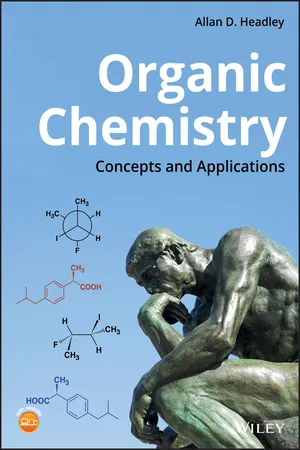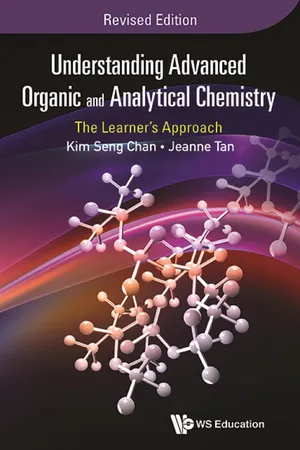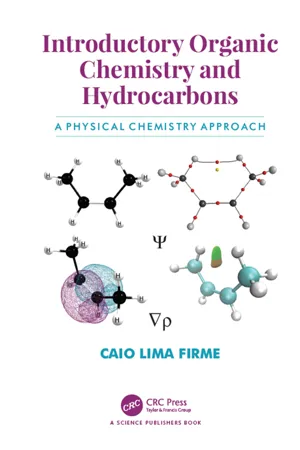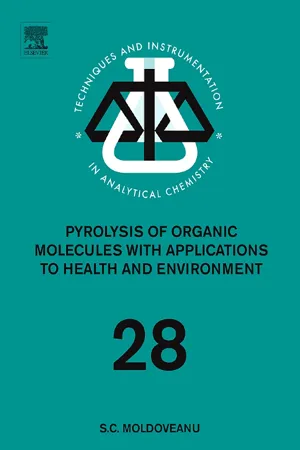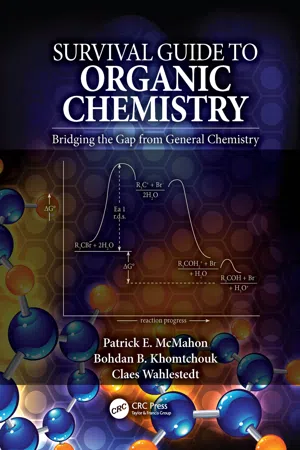Chemistry
Halogenation of Alkanes
Halogenation of alkanes is a chemical reaction in which a halogen, such as chlorine or bromine, replaces a hydrogen atom in an alkane molecule. This reaction is a type of substitution reaction and is typically carried out in the presence of ultraviolet light or heat. The halogenation of alkanes is an important process for the synthesis of various organic compounds.
Written by Perlego with AI-assistance
Related key terms
Related key terms
1 of 4
Related key terms
1 of 3
7 Key excerpts on "Halogenation of Alkanes"
- eBook - ePub
Organic Chemistry
Concepts and Applications
- Allan D. Headley(Author)
- 2019(Publication Date)
- Wiley(Publisher)
Alkanes are fairly inert compounds; some alkanes are used as solvents to provide inert media for different reactions that we will see in later chapters. In addition to combustion, alkanes undergo another type of reaction that is very important to organic chemists, and that is the reaction with halogens, specifically chlorine or bromine in the presence of energy in the form of heat or light. As the name suggests, this reaction involves the reaction of alkanes and bromine or chlorine and is called bromination or chlorination of alkanes, respectively. These reactions are performed in the presence of light or heat and are described as substitution reactions since a hydrogen or more than one hydrogen atoms of an alkane reactant are substituted for a halogen or more than one halogen in the product. Most of the reactions that will be encountered in this chapter involve the substitution of one hydrogen in the alkane for a halogen in the product.The products produced upon the chlorination of alkanes are alkyl halides, most are important industrial raw material for the synthesis of numerous other chemicals. For example, chloromethane was used once as a refrigerant, but discontinued owing to its flammability and toxicity. Today, it is widely used as a chemical intermediate for the production of different compounds, including polymers. Other chloroalkanes are widely used as a solvent in the research labs and in the production of rubber and in the petroleum refining industry. The chlorination of methane is shown in Reaction (14‐5) .(14‐5)To be able to predict the products of these and other similar reactions, a thorough understanding of how the reaction occurs is essential. Before we examine the reaction mechanism for the chlorination of alkanes, let us examine the process of bond reorganization for the reaction shown in Reaction (14‐5) . It should be obvious that this reaction is a substitution reaction in which a Cl─Cl bond has to be broken and the chlorine atoms form two new bonds, a new H─Cl bond and a new C─Cl bond in the CH3 - eBook - ePub
- Andrew F. Parsons(Author)
- 2013(Publication Date)
- Wiley(Publisher)
5 Br.- An alicyclic halogenoalkane has the carbon atoms in a closed ring, but the ring is not aromatic, e.g. bromocyclohexane, C6 H11 Br.
- An aromatic halogenoalkane has the carbon atoms in a closed ring and the ring is aromatic, e.g. bromobenzene, C6 H5 Br.
The formation of bromobenzene from benzene is discussed in Section 7.2.15.2 Preparation
5.2.1 Halogenation of Alkanes
Chloroalkanes (RCl) or bromoalkanes (RBr) can be obtained from alkanes (RH) by reaction with chlorine or bromine gas, respectively, in the presence of UV radiation. The reaction involves a radical chain mechanism.Radicals are introduced in Section 4.1 Radical reactions are discussed in Section 4.6.2This is a substitution reaction as a hydrogen atom on the carbon is substituted for a Cl or Br atom. A mixture of halogenated products is usually obtained if further substitution reactions can take place.Chloroalkanes, such as CH2 Cl2 (dichloromethane), are common solvents in organic synthesisPrimary, secondary and tertiary halogenoalkanes are defined in Section 2.1The ease of halogenation depends on whether the hydrogen atom is bonded to a primary, secondary or tertiary carbon atom. A tertiary hydrogen atom is more reactive because reaction with a halogen atom (X• ) produces an intermediate tertiary radical, which is more stable (and therefore more readily formed) than a secondary or primary radical (Section 4.3).5.2.2 Halogenation of Alcohols
Alcohols (ROH) are converted into halogenoalkanes using a number of methods. All methods involve ‘activating’ the OH group to make this into a better leaving group (Section 5.3.1.4). Reaction mechanisms are introduced in Section 4.11The mechanism of these reactions depends on whether a primary (RCH2 OH), secondary (R2 CHOH) or tertiary alcohol (R3 - eBook - ePub
Understanding Advanced Organic and Analytical Chemistry
The Learner's ApproachRevised Edition
- Kim Seng Chan, Jeanne Tan;;;(Authors)
- 2016(Publication Date)
- WS EDUCATION(Publisher)
CHAPTER 7
Halogen Derivatives
7.1 Introduction
Halogenoalkanes, also known as alkyl halides, are saturated organic compounds that contain the −C−X functional group (X = F, Cl, Br or I). They are important derivatives of alkanes and have the general formula Cn H2n+1 X. An example is bromoethane:Halogenoalkanes do not occur naturally. In fact, they are the by-products of the reaction of alkanes or alkenes with halogen, as these hydrocarbons are commonly found in petroleum. Halogenoalkanes are generally known as the “workhorse” in organic chemistry as they are very useful intermediates to be converted to other more important specialty chemicals of greater economic value. Some halogenoalkanes, such as chlorofluorocarbon, can also be harmful to the environment.Halogenoarenes (or aryl halides) are aromatic compounds with a halogen atom directly attached to the benzene ring. Similar to halogenoalkanes, halogenoarenes do not occur naturally and are in fact synthesized by reacting aromatic compounds isolated from petroleum with halogens.7.2 Nomenclature
A halogenolkane is obtained when one or more hydrogen atoms of an alkane molecule have been replaced by halogen atoms via the free radical substitution reaction. Other than this, halogenoalkanes can also be obtained when hydrogen halide (HX) or the diatomic halogen molecules add across an alkene double bond through the electrophilic addition mechanism. Thus, one can simply perceive halogenoalkanes as substituted alkanes. Therefore, halogenoalkanes are named in a similar manner to alkanes — the suffix ends in — ane - eBook - ePub
Introductory Organic Chemistry and Hydrocarbons
A Physical Chemistry Approach
- Caio Lima Firme(Author)
- 2019(Publication Date)
- CRC Press(Publisher)
The substitution reaction in alkanes is a halogenation reaction where an alkyl halide is formed (Fig. 14.16). Firstly, light (represented as hv) breaks the weak bond in halogen molecule (for example, in chlorine molecule) to form two halide radicals (e.g., two chlorine radicals) in the initiation step. In the next step, the halide radical abstracts one hydrogen atom of the alkane (e.g., in ethane) to form a new bond and molecule (hydrogen halide, e.g., HCl) and a new radical (the alkyl radical, e.g., ethyl radical). As soon as an alkyl radical is formed, it starts to react with unreacted halogen molecule to form alkyl halide and a new halide radical (for example, ethyl radical forming a new bond with a chlorine atom after cleavage of the chlorine-chlorine bond). As the concentration of alkyl halides and halide radical increases, the termination step increases as well until the end of the reaction. Figure 14.16 Mechanism of radical substitution between chlorine molecule and ethane. From ω B97XD/6-31G++(2 d,p) level of theory, we have found the first transition state depicted in Fig. 14.16. In Fig. 14.17, the intrinsic reaction coordinate (IRC) from this transition state (abstraction of hydrogen atom of ethane from chlorine radical) is depicted, where reactants (chlorine radical and ethane) appear on the right and products/intermediates (HCl and ethyl radical) appear on the left of the IRC curve. The second transition state (according to the scheme in Fig. 14.16) was not found from this level of theory, even by using more robust techniques of calculation - eBook - ePub
Pyrolysis of Organic Molecules
Applications to Health and Environmental Issues
- Serban C. Moldoveanu(Author)
- 2009(Publication Date)
- Elsevier Science(Publisher)
Chapter 8 Pyrolysis of Halogenated Hydrocarbons
S.C. Moldoveanu
8.1. Chlorinated aliphatic hydrocarbons
General aspects
The replacement in a hydrocarbon of one or more hydrogen atoms with chlorine atoms leads to the class of chlorinated hydrocarbons. This replacement can be performed on any kind of hydrocarbon, including linear, branched, or cyclic, saturated or unsaturated, as well as aromatic. Chlorinated hydrocarbons are also known as chlorocarbons and can be viewed as formed from an organic radical (alkyl, cycloalkyl, aryl, etc.) and one or more chlorine functional groups. In chlorinated aliphatic hydrocarbons, the chlorine atoms are attached to an aliphatic structure. The compounds such as benzyl chloride, where, besides chlorine, the aliphatic structure is substituted with an aryl group, are still considered aliphatic.For a single hydrocarbon, there are many possibilities for hydrogen replacements. For propane, for example, there are 29 possible chlorinated derivatives, for n-hexane there are 666, and for n-heptane there are 1998. A large number of all the possible chlorinated compounds have not been individually prepared and do not have a particular application. However, some chlorinated hydrocarbons are important industrial and consumer products. Among these are compounds used as intermediates in industrial organic synthesis, chlorinated monomers used in polymer industry such as vinyl chloride and 1,1-dichloroethylene, and chlorinated solvents such as tetrachloroethylene, 1,2-dichloroethane, methylene chloride, and chloroform.A variety of other uses can be found for chlorinated compounds. These include pesticides and herbicides (common examples being lindane, mirex, and aldrin), disinfectants, flame retardants (e.g., Dechlorane Plus), and pharmaceuticals. However, most of these compounds have more complex structures including, besides chlorine, other molecular structures (e.g., heterocycles), as well as additional functional groups such as OH, NH2 - eBook - ePub
Survival Guide to Organic Chemistry
Bridging the Gap from General Chemistry
- Patrick E. McMahon, Bohdan B. Khomtchouk, Claes Wahlestedt(Authors)
- 2016(Publication Date)
- CRC Press(Publisher)
electron donation .- Directly attached carbon groups (alkyl-substituent groups) are more efficient than substituted hydrogen atoms at donation of electron density to electrophilic carbon. This is due to the versatility (inductive and hyperconjugative effects) of the bonding electrons in the carbon group.
- The net result is that a positive charge or radical on electrophilic carbon is more stable (i.e., "“less unfavorable”) whenever the electrophilic carbon itself is bonded to the greatest number of alkyl groups (carbon groups ).
- Summary:
12.2 FREE RADICAL Halogenation of Alkanes/ALKYL GROUPS
12.2.1 REACTION CONCEPTS
- The overall reaction is a net substitution of a hydrogen for a halogen in an alkane to form an alkyl halide; the other product is a hydrogen halide. The carbon being substituted can be methyl, primary, secondary, or tertiary. The halogen is usually either diatomic Cl2 or Br2 . Light often is used to initiate the reaction.
- The rate of the reaction depends primarily on the alkyl-substitution pattern of the carbon which undergoes the halogen/hydrogen exchange.
- The rate-limiting step involves the breaking of the C — H bond to form a carbon radical. The ease of bond breaking follows the trends for radical stability.
- Resulting summary: (R = specifically an alkyl group )
- Hydrogens can be designated by the type of carbon they are bonded to: Tertiary hydrogen is a hydrogen bonded to a tertiary carbon; a secondary hydrogen is a hydrogen bonded to a secondary carbon; and a primary hydrogen is a hydrogen bonded to a primary carbon.
- The major product in a free radical reaction generally follows the relative rates of reaction for the corresponding hydrogen exchange . This is especially true for reaction with the halogen Br2 . Exchange of H for X will occur primarily at the tertiary C — H position if present in the molecule, followed by a secondary C — H followed by a primary C—H. Major product formation, based on potential available C—H
- eBook - ePub
- Harold A. Wittcoff, Bryan G. Reuben, Jeffery S. Plotkin(Authors)
- 2012(Publication Date)
- Wiley(Publisher)
Chapter 13 Chemicals from AlkanesAlkanes occur as such in natural gas and petroleum, and accordingly are the cheapest raw materials for chemicals. They are the feedstocks for cracking (Sections 4.5 and 4.6) and catalytic reforming (Section 4.8). Methane is the main source for synthesis gas (Section 12.4.1) via steam reforming. The higher alkanes can be subjected to the same process if desired, or the steam reforming process can be redirected to give methane. An important process is pyrolysis of hydrocarbons to carbon black, which is discussed at the end of this chapter.Apart from pyrolysis, these reactions are endothermic and accompanied by an increase of entropy. They are all unselective and take place at high temperatures. There are few long-established examples of alkane functionalization, that is, of the use of alkanes directly for downstream chemicals. The most important are the conversion of n -butane to maleic anhydride (Section 7.4.2), the oxidation of n -butane or naphtha to acetic acid (Section 12.5.2.2), the oxidation of isobutane to t -butylhydroperoxide (Section 6.8), the oxidation of ethylbenzene to ethylbenzene hydroperoxide (Section 6.8), and the chlorination of methane (Section 12.2). Lesser volume uses involve ammoxidation of methane to hydrocyanic acid (Section 12.1), conversion of methane to acetylene (Section 12.3), and nitration of propane. These have largely been discussed.Any alkane may be nitrated. In practice only propane is used as feed, and from its nitration result nitromethane, nitroethane, and 1- and 2-nitropropane. The nitration takes place at 420°C, and the products are separated by distillation. They are used as additives for gasoline for racing cars, as solvents especially for polycyanoacrylates, and as stabilizers of chlorinated solvents. DuPont developed a process for the nitration of cyclohexane to nitrocyclohexane as a step in a caprolactam synthesis (Section 9.2.2) but it is not currently used.
Index pages curate the most relevant extracts from our library of academic textbooks. They’ve been created using an in-house natural language model (NLM), each adding context and meaning to key research topics.
Explore more topic indexes
Explore more topic indexes
1 of 6
Explore more topic indexes
1 of 4
